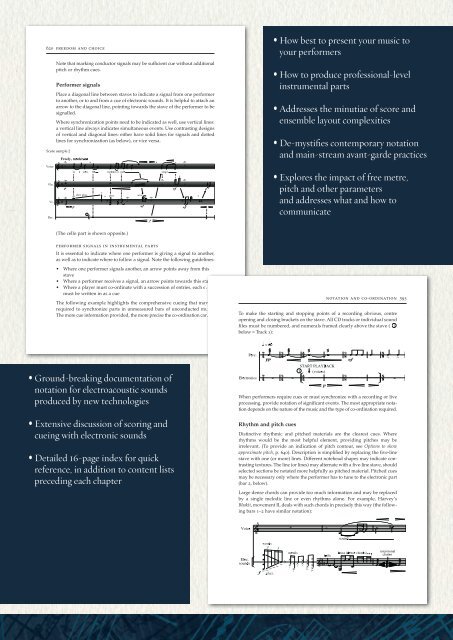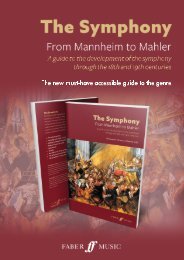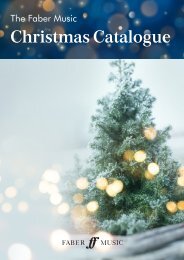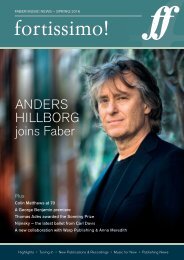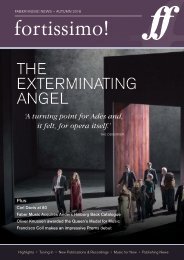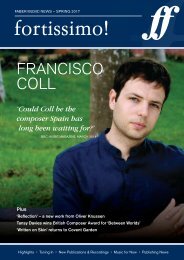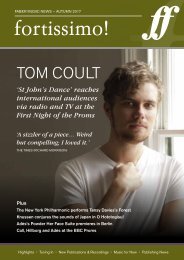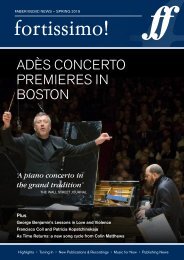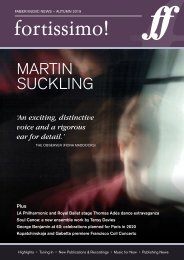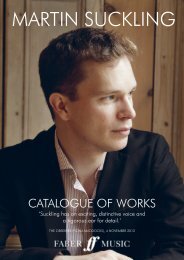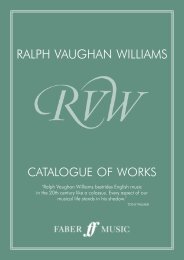Behind Bars the definitive guide to music notation
Specialist music editor Elaine Gould provides a comprehensive grounding in notational principles in this seminal reference work, the most thorough guide ever published in this field. An essential resource for composers, editors, music setters, students and teachers, Behind Bars covers everything from basic rules of mainstream practice to complex instrumental and vocal techniques and new technologies.
Specialist music editor Elaine Gould provides a comprehensive grounding in notational principles in this seminal reference work, the most thorough guide ever published in this field. An essential resource for composers, editors, music setters, students and teachers, Behind Bars covers everything from basic rules of mainstream practice to complex instrumental and vocal techniques and new technologies.
Create successful ePaper yourself
Turn your PDF publications into a flip-book with our unique Google optimized e-Paper software.
620 freedom and choice<br />
Note that marking conduc<strong>to</strong>r signals may be sufficient cue without additional<br />
pitch or rhythm cues.<br />
Performer signals<br />
Place a diagonal line between staves <strong>to</strong> indicate a signal from one performer<br />
<strong>to</strong> ano<strong>the</strong>r, or <strong>to</strong> and from a cue of electronic sounds. It is helpful <strong>to</strong> attach an<br />
arrow <strong>to</strong> <strong>the</strong> diagonal line, pointing <strong>to</strong>wards <strong>the</strong> stave of <strong>the</strong> performer <strong>to</strong> be<br />
signalled.<br />
Where synchronization points need <strong>to</strong> be indicated as well, use vertical lines:<br />
a vertical line always indicates simultaneous events. Use contrasting designs<br />
of vertical and diagonal lines: ei<strong>the</strong>r have solid lines for signals and dotted<br />
lines for synchronization (as below), or vice versa.<br />
• How best <strong>to</strong> present your <strong>music</strong> <strong>to</strong><br />
your performers<br />
• How <strong>to</strong> produce professional-level<br />
instrumental parts<br />
• Addresses <strong>the</strong> minutiae of score and<br />
ensemble layout complexities<br />
• De-mystifies contemporary <strong>notation</strong><br />
and main-stream avant-garde practices<br />
• Explores <strong>the</strong> impact of free metre,<br />
pitch and o<strong>the</strong>r parameters<br />
and addresses what and how <strong>to</strong><br />
communicate<br />
(The cello part is shown opposite.)<br />
performer signals in instrumental parts<br />
It is essential <strong>to</strong> indicate where one performer is giving a signal <strong>to</strong> ano<strong>the</strong>r,<br />
as well as <strong>to</strong> indicate where <strong>to</strong> follow a signal. Note <strong>the</strong> following <strong>guide</strong>lines:<br />
• Where one performer signals ano<strong>the</strong>r, an arrow points away from this<br />
stave<br />
• Where a performer receives a signal, an arrow points <strong>to</strong>wards this stave<br />
• Where a player must co-ordinate with a succession of entries, each entry<br />
must be written in as a cue<br />
The following example highlights <strong>the</strong> comprehensive cueing that may be<br />
required <strong>to</strong> synchronize parts in unmeasured bars of unconducted <strong>music</strong>.<br />
The more cue information provided, <strong>the</strong> more precise <strong>the</strong> co-ordination can be:<br />
<strong>notation</strong> and co-ordination 593<br />
To make <strong>the</strong> starting and s<strong>to</strong>pping points of a recording obvious, centre<br />
opening and closing brackets on <strong>the</strong> stave. All CD tracks or individual sound<br />
files must be numbered, and numerals framed clearly above <strong>the</strong> stave (<br />
below = Track 1):<br />
• Ground-breaking documentation of<br />
<strong>notation</strong> for electroacoustic sounds<br />
produced by new technologies<br />
• Extensive discussion of scoring and<br />
cueing with electronic sounds<br />
• Detailed 16-page index for quick<br />
reference, in addition <strong>to</strong> content lists<br />
preceding each chapter<br />
When performers require cues or must synchronize with a recording or live<br />
processing, provide <strong>notation</strong> of significant events. The most appropriate <strong>notation</strong><br />
depends on <strong>the</strong> nature of <strong>the</strong> <strong>music</strong> and <strong>the</strong> type of co-ordination required.<br />
Rhythm and pitch cues<br />
Distinctive rhythmic and pitched materials are <strong>the</strong> clearest cues. Where<br />
rhythms would be <strong>the</strong> most helpful element, providing pitches may be<br />
irrelevant. (To provide an indication of pitch con<strong>to</strong>ur, see Options <strong>to</strong> show<br />
approximate pitch, p. 640). Description is simplified by replacing <strong>the</strong> five-line<br />
stave with one (or more) lines. Different notehead shapes may indicate contrasting<br />
textures. The line (or lines) may alternate with a five-line stave, should<br />
selected sections be notated more helpfully as pitched material. Pitched cues<br />
may be necessary only where <strong>the</strong> performer has <strong>to</strong> tune <strong>to</strong> <strong>the</strong> electronic part<br />
(bar 2, below).<br />
Large dense chords can provide <strong>to</strong>o much information and may be replaced<br />
by a single melodic line or even rhythms alone. For example, Harvey’s<br />
Bhakti, movement II, deals with such chords in precisely this way (<strong>the</strong> following<br />
bars 1–2 have similar <strong>notation</strong>):


